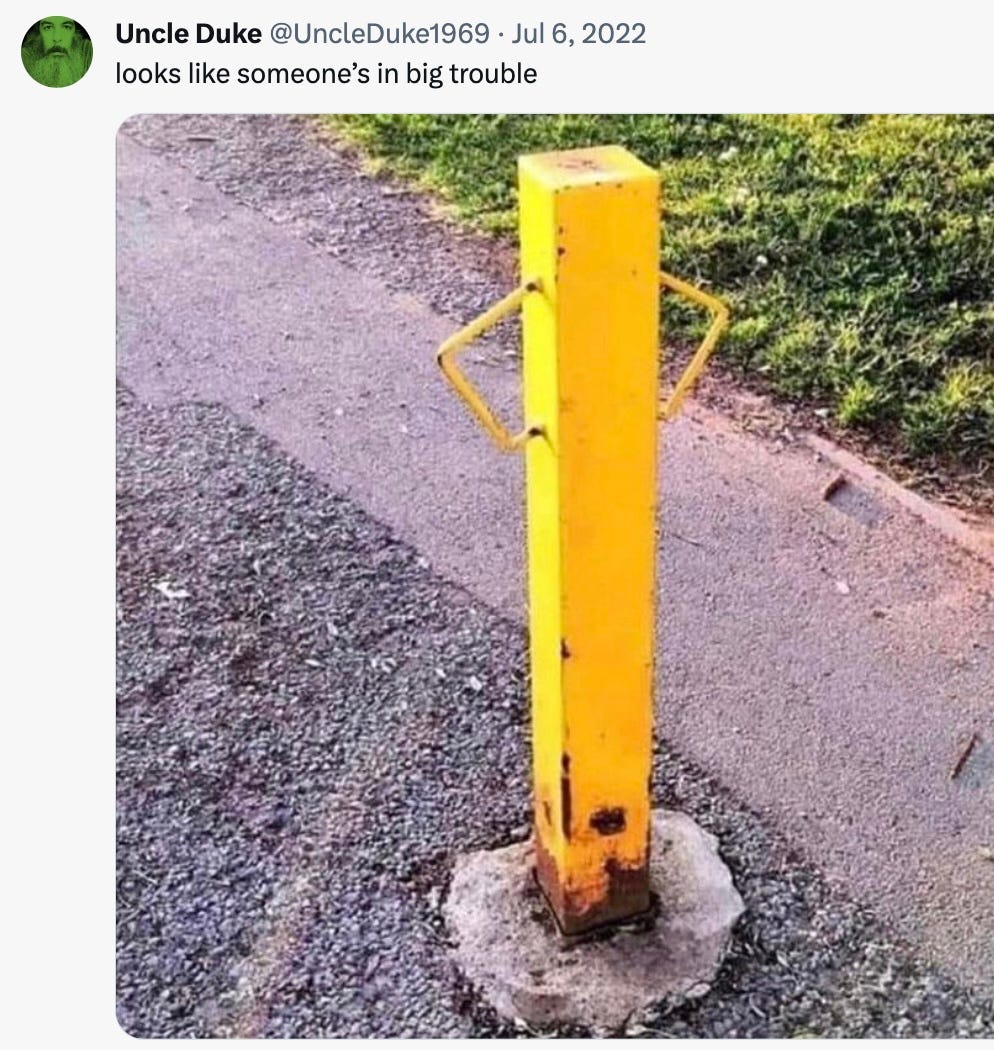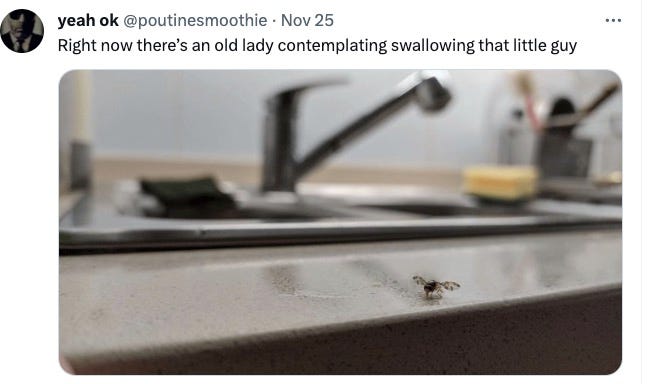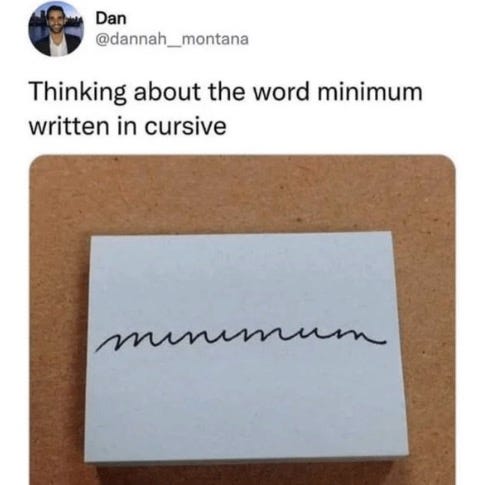Marduk is also not the reason for the season
& beautiful thoughts about football rules, beautifully expressed
To read this issue in your browser, click on the headline above.
I am a former opinion columnist for the Chicago Tribune. Find a longer bio and contact information here. This issue exceeds in size the maximum length for a standard email. To read the entire issue in your browser, click on the headline link above. Paid subscribers receive each Picayune Plus in their email inbox each Tuesday, are part of our civil and productive commenting community and enjoy the sublime satisfaction of supporting this enterprise.
Tuesdays at 11:30 a.m. I talk with WGN-AM 720 host John Williams about what’s making news and likely to be grist for the PS mill. The WGN listen-live link is here.
Any special plans for Zagmuk this year?
Don’t be fooled by any pious claims that Jesus is “the reason for the season.”
Civilizations all over the northern hemisphere have been making merry toward the end of December for thousands of years, with most of the celebrations linked somehow to the "return" of the sun--the longer periods of daylight that begin on the winter solstice, Dec. 21.
Jesus is no more the initial reason many of us celebrate this time of year than Marduk.
Some 4,000 years ago in ancient Mesopotamia, Marduk was the patron deity of the city of Babylon. Marduk was said to have conquered the monster of chaos, Tiamat, and thus paved the way for creation. But every year, alas, the monster fought back, the fields went barren, the days got shorter and life itself hung in the balance.
The 12-day late-December Zagmuk throwdown, then, was replete with rituals believed to help Marduk win his annual battle with Tiamat, and then to celebrate the return of light.
Ancient Romans celebrated Saturnalia during roughly the same calendar window, while the Persians observed the festival of Sacaea. History does not record whether peevish Mesopotamians, perceiving a dilution of their seasonal tradition, began a campaign to "put Marduk back into Zagmuk."
But even by then, the season belonged to many cultures and was viewed as a magical, mysterious and portentous time.
Quite a coincidence that Jesus Christ was born at a time when folks all over were already partying, eh?
Well, probably not. Scholars don't even agree on the year Jesus was born, much less the month or day. Given the reported presence of shepherds watching their flocks by night, the best guess is sometime in the late spring or early fall. If you have lots of time on your hands, Google the phrase "When was Jesus born?" and start poking around the 13,000 Web sites where exegetes and skeptics alike parse the text and history books for answers.
The question didn't seem to concern early Christians all that much. It wasn't until 350 A.D. that Pope Julius I of Rome fixed the date for the Feast of the Nativity on December 25.
It looked like a cynical choice designed to co-opt the wanton hoo-haw already raging at that time of year, and not an educated estimate.
Early American Puritans were among the Christians who felt the choice amounted to unseemly piggy-backing: "It was in compliance with the pagan Saturnalia that Christmas Holy Days were first invented," sniffed Puritan pastor and Harvard president Increase Mather in 1687, explaining why those in his denomination scorned the observance.
But, hey. Whatever the source of his calculations, Pope Julius got it right. Christmas is not the holiest day on the Christian calendar--that would be Easter--but it's become by far the biggest.
The reason? Sunlight.
Sunlight is also, coincidentally, said to be the best disinfectant--here a disinfectant to kill the toxic notion that any one faith "owns" this season of renewal, hope, joy, generosity and the victory over darkness.
"Season's greetings" and "happy holidays" take nothing from the Christians who also chose this time of year to celebrate the birth of their divine source of renewal, hope, joy, generosity and victory. Jesus is their reason we make merry in this season, not the reason.
These generic expressions are not banalities that trivialize the festivities.
They are invitations to all to join in. Invitations to find and revel in your own reasons to be glad for the trappings and trimmings of this time of year and the promise that lies ahead.
Notes and comments from readers — lightly edited — along with my responses
Last week’s stop-action look at a controversial altercation in a Chicago schoolyard — “Let’s go to the video: Felony aggravated battery or just a nasty shove?” — drew a lot of response. If you’d like to watch the entire video (it’s short, just a minute and a half) click here.
G.T. — Craig Lancaster, the adult who shoved 14-year-old JaQuwaun Williams, is a police officer, which means he's armed with a gun. His attacking anyone should automatically be felony aggravated battery.
Aviva P. — It is quite clear that Lancaster, the police officer, moved to the right as JaQuwaun approached (about the 40 second mark in the video). JaQuwaun was walking across the playground in the direction of where the teacher and officer were standing, but not directly toward him as one might be doing to cause a physical confrontation. And if he had been doing that, the appropriate response would be for the officer to step to the left to avoid a collision, not to the right to provoke one.
JaQuwaun’s hands are by his side so there is no physical threat. He also does not appear to be looking at either of them. Whether or not he said anything offensive is irrelevant. Physical violence is not the appropriate response to speech. And it is especially inappropriate when used by a police officer and doubly so when used against a child.
Only a jerk (or someone who thinks he's entitled to control other people's space and movement) would deliberately cause a collision just to make a point about who has the most power.
Zorn — Watch the teacher standing with Lancaster. She takes a step back as JaQuwaun approaches — in at least some alarm. Why? What did he say that caused her to step back and caused the girl in the upper left to turn her attention toward him? Something, obviously. I’m not saying the cop’s response was necessary or appropriate, but just that the idea it was utterly unprovoked does not seem right.
Battery can be a legally acceptable response to speech if that speech leads a person to reasonably believes a proactive violent response is necessary to defend himself, herself or another person. Again, that seems unlikely in this case
Steven K. —I’’m very curious about what the kid might have said or done. Perhaps the cop is a complete psycho who just randomly pummels teenagers without any provocation. I guess that could be possible. Far more likely the kid said something provocative or threatening to someone else in the scene, and if his exact words are ever verifiably confirmed, I’d venture a guess that most sane observers will conclude that the roughing up this kid got from the cop was well deserved. And by “well deserved” I don’t mean that the shove was legally acceptable. The cop’s behavior was out of bounds, he should have his day in court, go before the judge, get a stiff admonishment and a small fine, and that should be the end of it.
But of course, it won’t be. The kid’s lawyers are, of course, histrionically blowing this into something that it is not, all with the goal of maximizing the payout from the windfall that they know surely awaits.
Zorn — I don’t know about “we’ll deserved” or even “deserved,” but I continue to question the charge of felony aggravated battery based on this altercation. I hope this case goes to trial and we learn much more, but my guess is the city will settle it for under $100,000 rather than risk an enormous judgment.
Joanie W. — We don’t know why the teacher stepped back. We don’t know that the teacher was alarmed as opposed to surprised or some other emotion. We do know that the teacher was not afraid of JaQuwaun because after Lancaster hit him in the throat and knocked him back, the teacher interposed herself between the cop and the boy, and grabbed the boy by both arms. So the idea that the officer had to hit the boy to protect the teacher seems pretty farfetched.
Yes, but the idea that Lancaster should go to prison and/or the city should pay out big bucks over this one shove also seems farfetched.
Just a matter of time
John L. — Baseball’s addition of a pitch clock reminded me of a nit I like to pick with football, namely calling a play-clock violation a “delay of game” penalty. Why not call it a “play-clock violation” like baseball and basketball do?
Zorn— Indeed. If delaying the game were such a concern for football execs, they wouldn’t have four-minute commercial breaks after punts and scoring plays, they’d have close calls reviewed remotely and quickly and they’d shorten halftime.
I went down a Google-hole trying to find out when the play clock was introduced and didn’t find an answer but did find “Forgotten Innovations: Football Without A Game Clock” on Timothy Brown’s Football Archeology Substack:
The idea that football should be a time-based game has been challenged twice over the years, and for different reasons. The first challenge arose in 1920 when Harry R. Coffin, a Harvard grad, argued that football's quarters should last 40 plays each (excluding plays in which penalties occurred). ….The 40-play system popped up again in (the 1940s when) Big Ten coaches recommended the rules committee adopt the 40-play system, though many derided their recommendation, arguing the game clock added excitement near the end of halves or games.
From this essay I learned that the two-minute warning in the NFL is a (ridiculous, unnecessary) holdover from the days when refs on the field kept the official game clock on a stopwatch and there was no electronic scoreboard for the players. It remains as another excuse for TV commercials.
I also found writer Mitch Rosenberg’s Sports Illustrated essay, “The NFL Should Abolish the Play Clock in Favor of a Better System:”
First: The game clock would start when the ball is placed on the line of scrimmage, pause momentarily when the play ends, and restart when the ball is placed on the line of scrimmage again.
Second: We would replace the play clock with a first-down clock. It would work like this: On any first down, it would be set to two minutes. It would start running whenever the ref set the ball and stop whenever the ball is snapped. This would give teams two minutes of cumulative presnap time before getting a first down. If they used 90 seconds on first down, they would have 30 left for the next three downs. If they used a total of 30 on the first three downs, they could use 90 on fourth. …
Would this system affect the number of plays in a game? Hard to say. The goal here is not to change the amount of action; it is to eliminate the obsession with the clock. The average NFL game features 153 plays. The average play takes around four seconds but takes roughly 24 seconds off the clock. The NFL league could do the math down to the second to figure out what would happen under the new system—and if the first-down clock needed to be lengthened or shortened based on that math, the NFL could do it.
My modified proposal is for the game clock to stop at the whistle on every play in the last minute or two of each half, all but eliminating the “victory formation” snap and the necessity for losing teams to avoid throwing passes to receivers in the midle of the field as the clock is winding down.
The last two minutes would then go a lot slower, so to prevent games from running even longer, the clock should then run non-stop for the first 10 minutes of each half.
Say what you will about baseball, but at least the game is played as it was meant to be played all the way to the final out. A team with a big lead can’t protect its victory by wasting time.
Such a reform in football would also eliminate the weird play in which a quarterback takes the snap and immediately throws the ball directly down into the turf in order to stop the clock near the end of the half.
The Christian Science Monitor reports:
This strategy for stopping the clock became legal in the early 1990s and has become standard operating procedure … since. It is a legal form of intentional grounding, since the quarterback is not looking to avoid a sack and immediately throws the ball to the ground after taking the snap. It is treated as an incomplete pass. For it to be legal, the quarterback has to be under center. Previously, quarterbacks had to throw the ball out of bounds to stop the clock. Without a doubt, it's one of the more comical-looking plays in football, but one that is often crucial to sustaining last-minute scoring drives.
My COVID-19 alarm: Unnecessary?
Daniel B. — I’m a fully vaccinated and boosted physician. And your claim in Land of Linkin’ that there’s an “ ominous covid 19 resurgence” is way off and unnecessarily alarmist. And your suggestion that we lower or eliminate the cost of testing is off base. More testing, regardless of price, wouldn’t change anything. We are experiencing the evolution of a coronavirus from potentially lethal to one that has mutated and become much more contagious and less lethal as a result of widespread exposure and vaccination. Given the high asymptomatic transmission of the current strains, there’s no known benefit to masking or testing. People are free to do what they are comfortable with, but suggesting that masking protects others is the same as saying that those who don’t mask choose to not care about others. Vaccines reduce morbidity and mortality, not transmission. If you feel sick, stay home and go back out when you’re better.
Wendy C. —Testing is important so you can advise close contacts of possible exposure. I work in a public school and many staff and students are masking up to reduce potential exposure to the virus, particularly when they know they have been in close contact with someone who has tested positive. For myself, I'm in a high-risk group and still mask in public buildings and stores. It’s wrong to dismiss COVID as no longer serious an illness. We lost a teacher to the virus a week ago.
Zorn — This month, KQED reported:
While COVID-19 rates may have fallen from that peak in the first weeks of September, the numbers now appear to be slowly ticking back up — just as the holiday season approaches. And with winter around the corner, another new subvariant has become prominent: HV.1.
Though COVID isn't being tracked as intensely since the pandemic ended, Midwestern and Western states have recently seen the highest rates of positive tests.
And nationwide, COVID hospitalizations were up 8.6% in the most recent week for which the CDC has data, but still far below pandemic levels.
That feels a bit ominous to me, though I am not a doctor.
Pundemonium
Peter Z— You had a special “Dad Tweets” poll last week. Here are a few more for you:
What is the leading cause of dry skin? Towels
Two antennas got married. The ceremony was just OK. But the reception was incredible!
The rotation of the earth makes my day!
Apologies to subscribers..this was like a bad joke sneeze, had to get it out.
Kind words
Steven K. — Let us all give thanks for the Picayune Sentinel. Amid a declining media landscape that is increasingly dominated by sensationalism, vapidity, rank political bias, grammatical ineptness, linguistic laziness, sound and fury, PS continuously provides a twice weekly oasis to slake the thirst for intelligent, thought provoking reportage and commentary.
Zorn — Thanks so much. I try. And I give thanks for all my readers, particularly my paid subscribers who are like family to me.
This is a good time to remind paying customers once again of two things:
Many of you are coming up on your automatic renewal dates because the support program launched in early December two years ago. I have very little control over how the subscription interface works, but in the interest of extra transparency, I want to give you that heads-up (and urge those of you who have changed credit cards in the last year and are willing to continue supporting this publication to update your information.
A subscription to the Picayune Sentinel is an excellent holiday gift! Thoughtful, personal, just the right size and color. And gift subscriptions do not automatically renew.
Tom T. — I am proud to be a founding member of the Picayune Sentinel and plan to continue my yearly subscription. I appreciate the amount of effort you put in each week. When I consider how much time I spend on and enjoyment I get from your newsletter the annual cost seems minimal.
One question I have is what happened with the Daily Herald? I was expecting that they would use your material more than they have. Happy Anniversary to the Picayune Sentinel. I wish you many more years of continued success.
Zorn — Thanks for the kind words and the support. Many more years sounds good to me. After I left the Tribune and started the Picayune Sentinel, editors at the Daily Herald proposed to regularly scrape the publication for column-like content and pay me a modest freelance fee for each use of my material. After just a few such appearances in their pages, a Herald editor told me the paper no longer had a freelance budget. That seemed plausible to me given the state of print journalism (though if there are freelancers out there doing gig work for the Daily Herald I’d like to know about it!), so I then agreed to let them use my stuff from time to time for free as long as it included an italic tag pointing interested readers to ericzorn.substack.com. And that’s pretty much the last I heard from my friends in Arlington Heights.
Mike J. — Is the omission (for the second year in a row) of your holiday singalong, “Songs of Good Cheer” at The Old Town School from the Tribune’s listings of upcoming holiday musical programs an oversight or retribution for exposing their payment scams?
Zorn — I prefer to think of it as an oversight. The Tribune was very active in sponsoring and promoting SOGC for many years — it was the model for “Trib Nation” a series of live events that promoted the newspaper through outreach to readers. Mary Schmich and I were ambassadors for the Trib at those early shows, and many top editors emceed the program and even sang on stage with us.
We’ve tried to maintain the connection as a win-win, but have been rebuffed; our olive branches ignored. Yet if anyone in the newsroom has a problem with my harping on the shady way subscriptions are priced — or thinks I’m misrepresenting the facts — they haven’t said so. Publisher Par Ridder, who has refused my many requests for comment, must think the ends justify the means.
What else do you want a smartphone to do?
My smartphone is my calculator, my dictionary, my camera, my stopwatch, my timer, my range-finder on the golf course, my reference library, my sports scoreboard, my metronome, my GPS guide, my jukebox, my audio recorder, my thermostat controller, my instrument tuner, my ruler, my heart monitor, my scanner and my source for background guitar tracks. It’s also the portal for nearly all the communication that I do including, occasionally, telephonic communication.
What else would I want or need?
I wish my smartphone were much better than it is at voice-to-text (a while back in texting to a friend I dictated a question asking what was on her schedule. V/T rendered it as "what’s on your sexy edible?")
I wish it allowed for real-time translation from foreign languages to English so I could conduct ordinary conversations with people from all over the world.
I wish it could read articles to me in a wholly natural, expressive voice indistinguishable from a good human reader.
I wish technology made stolen phones immediately and utterly useless and with little material value. It would cut down dramatically on street robberies.
When I posted these thoughts to Facebook, Michael Messinger added a wish that the smartphone be nearly indestructible./Teresa Savino expressed an interest in much longer battery life.
But as for applications, I can’t think of other capabilities I wish the phone had. And this makes me wonder how the manufacturers will continue to persuade us to upgrade. iPhones are at just about peak camera, and the functionality is astounding.
Other ideas, anyone?
Ya gotta see these tweets!
Here are some funny visual images I've come across recently on social media. Enjoy, then evaluate:
No one expects the “chief weapon” tweet to do all that well, as it requires knowledge of a sketch that first aired 53 years ago on “Monty Python’s Flying Circus,” a British Broadcasting Corporation program. But I was amused!
Vote for your favorite. I’ll share the winner in Thursday’s main edition along with the winner of last week’s visual tweets contest.
Usage note: To me, “tweet” has become a generic term for a short post on social media.
There’s still time to vote in the conventional Tweet of the Week poll! And the special “Dad Tweets” poll is very, very close at the top, so weigh in there, too, please.
Thank you for supporting the Picayune Sentinel. To help this publication grow, please consider spreading the word to friends, family, associates, neighbors and agreeable strangers.
.














EZ. Which of your list of items brings the current Covid situation to "ominous" in your opinion?
1. "the numbers now appear to be slowly ticking back up..."? Appear? Slowly?
2. "Midwestern and Western states have recently seen the highest rates of positive tests." Some geographic area has to have the highest rates, right?
3. "COVID hospitalizations were up 8.6% in the most recent week for which the CDC has data, but still far below pandemic levels." Tells me nothing other than up 8.6% from the week before. It's down 13% from the September 9th number and 25% from a year ago.
I thought Danial B's comments were solid. Pro vax, pro booster, pro stay at home, anti excessive testing and anti alarmist.
Eric:
I suspect "Secret weapon" would win in a landslide in the UK.